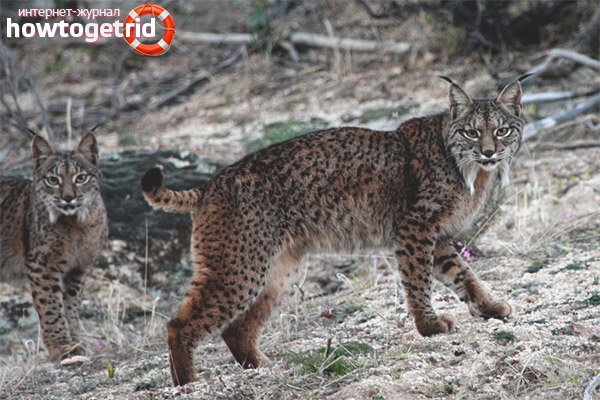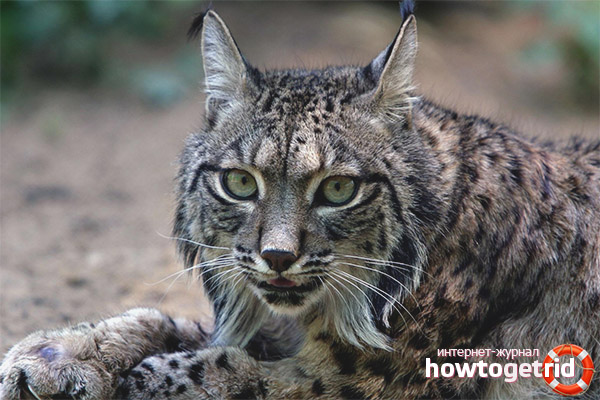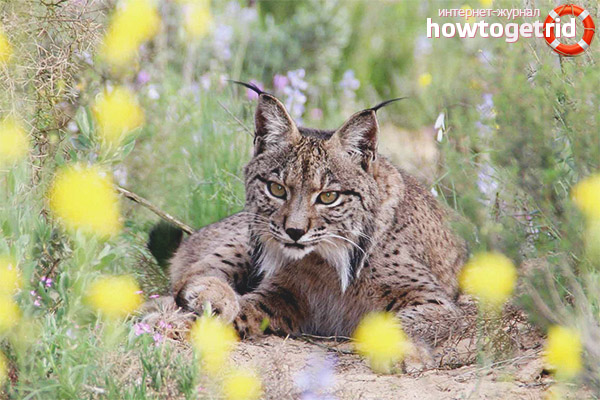The content of the article
The Pyrenees (Spanish, Sardinian) lynx is outwardly similar to its close relatives - the common lynx, Canadian and red. Although it is smaller. So, the height is 50-70 centimeters, the length is from 80 centimeters to 1 meter, the tail with a black tip is from 15 to 30 centimeters. Males, as usual, larger than females, weigh on average 13-14 kilograms (although there are individuals reaching 25 kg). Females take it easy - 9.5-10 kilograms.
The skull is shorter than that of the common lynx, the muzzle is flat and narrow, the jaws are quite long. But the fangs are smaller than those of cats that hunt large animals. This structure of the skull and muzzle allows you to easily catch a small quick prey and kill it instantly.
The ears are decorated with black tassels, the cheeks are framed by dark whiskers, which is why the animals look like carriers of beards. The fur is short - after all, where the Iberian lynx lives, it is warm, it is yellow-brown in color. Dark spots of various shapes and sizes adorn the entire surface of the body (including the paws). Coloring is very similar to leopard.
Habitat
Lives the Pyrenean lynx on the Iberian Peninsula, in the southwestern regions of Spain and almost throughout Portugal. Not so long ago (in the 19th century), the animal completely occupied the Spanish and Portuguese territories, but their number was very much reduced. Now the main part lives in the national reserve of Coto de Doñana.
Habitat
Breeding
Pyrenean lynxes are polygynous animals, that is, one male can mate not with one female, but with several. Lynx give birth only once during the year. The breeding season is quite long and coincides with the estrus in females - from January to July. Pregnancy lasts from 72 to 78 days. Peak of birth occurs in the first spring months - March and April. As already mentioned, the female gives birth in the undergrowth of a bush or looks for hollows in a cork oak. As a rule, three cubs weighing up to 250 grams are born, sometimes it reaches five, only a part of them dies. Only the mother is engaged in upbringing, the father is not interested in kittens and children; approximately every three weeks, as the kittens grow, the parent searches for a larger den and drags the children there. She does this so that the offspring are safe and, as expected, in order to avoid great infection with various parasites.
Kittens already eat raw meat in their second month of life, but their mother feeds them milk for up to five months. At six months, the young lynxes themselves already begin to hunt, but until they have completely decided on the hunting area (at about 20 months), they remain to live with their mother.
Nutrition
The structure of the skull and jaws allows the lynx to skillfully catch small animals. The small size combined with camouflage makes them excellent hunters for small mammals.
Iberian lynx is a solitary hunter, the basis of her diet is rabbits. For an adult animal, eat at least one carcass per day. Also, hares and various rodents, snakes, and birds turn out to be prey. The Iberian lynx catches fish in ponds and can grab and eat a gaping insect. It happens that the prey is a cub of a fallow deer, deer or mouflon.
With excellent eyesight and smell, most often the lynx freezes on a tree branch or in a shelter of rocks and awaits the approach of the victim, which it then attacks. The spotted hunter does not immediately eat the prey - he takes it away beforehand and only then proceeds to a meal. If it does not manage to cope with all the prey, then it hides and is eaten for tomorrow.
Lifestyle, behavior
Iberian lynx is a predator living a solitary life. They show activity at dusk, and are directly dependent on the activity of prey - the Pyrenees rabbit. In winter, when the rabbit lives a daily life, the lynx also switches to the same mode.
Each animal has its own plot, males have up to 18 square kilometers, females have less - up to 10. Their territories overlap, each sex protects its possessions from strangers and potential threats. Lynxes mark the boundaries of the sites with the help of smells - they mark with urine or excrement, they leave scratches on the trees.
If there is little food in the possessions, then the lynxes are aggressive and kill other animals, seeing them as competitors. Their victims are foxes, otters, ordinary dogs, mongooses.
Threats

Since the Pyrenean lynxes in the food chain occupy one of the top lines, they have no natural enemies. The only one who can be considered an enemy is man. For the sake of beautiful fur, most of the Spanish lynx was killed, and now it remains only two percent of the amount that existed in the 19th century.
Role in the ecological system
Security status
Iberian lynx is a species of rapidly endangered mammals. If at the end of the 19th - beginning of the 20th century there were more than one hundred thousand copies, then by the middle of the 20th a little more than 3 thousand remained, and by the beginning of the 21st century - only four hundred animals. This animal is listed not only in the Red Book, but also in all kinds of lists and conventions dedicated to endangered animals.
A special program for breeding lynx in captivity has been created, which will make it possible to restore the population.











Submit